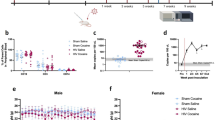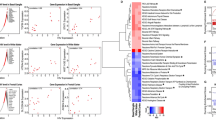Abstract
The medial prefrontal cortex (mPFC) is dysregulated in HIV-1-infected humans and the dysregulation is enhanced by cocaine abuse. Understanding mPFC pathophysiology in this comorbid state has been hampered by the dearth of relevant animal models. To help fill this knowledge gap, electrophysiological assessments were made of mPFC pyramidal neurons (PN) from adult male HIV-1 transgenic (Tg) F344 rats (which express seven of the nine HIV-1 toxic proteins) and non-Tg F344 rats that self-administered cocaine for 14 days (COC-SA), as well as saline-yoked controls (SAL-Yoked) and experimentally naive Tg and non-Tg rats. Forebrain slices were harvested and prepared for whole-cell patch-clamp recording, and in treated rats, this occurred after 14–18 days of forced abstinence. Aged-matched rats were used for immunohistochemical detection of the L-channel protein, Cav1.2-α1c. We determined that: (i) the two genotypes acquired the operant task and maintained similar levels of COC-SA, (ii) forced abstinence from COC-SA enhanced mPFC PN excitability in both genotypes, and neurons from Tg rats exhibited the greatest pathophysiology, (iii) neurons from SAL-Yoked Tg rats were more excitable than those from SAL-Yoked non-Tg rats, and in Tg rats (iv) blockade of L-type Ca2+ channels reduced the enhanced excitability, and (v) Cav1.2-immunoreactivity was increased. These findings provide the first assessment of the mPFC pathophysiology in a rodent model of HIV-1-mediated neuropathology with and without cocaine self-administration. Outcomes reveal an enhanced cortical excitability during chronic exposure to HIV-1 proteins that is excessively exacerbated with cocaine abuse. Such neuropathophysiology may underlie the cognitive dysregulation reported for comorbid humans.
Similar content being viewed by others
Log in or create a free account to read this content
Gain free access to this article, as well as selected content from this journal and more on nature.com
or
References
Aksenov MY, Aksenova MV, Nath A, Ray PD, Mactutus CF, Booze RM (2006). Cocaine-mediated enhancement of Tat toxicity in rat hippocampal cell cultures: the role of oxidative stress and D1 dopamine receptor. Neurotoxicology 27: 217–228.
Brailoiu GC, Brailoiu E, Chang JK, Dun NJ (2008). Excitatory effects of human immunodeficiency virus 1 Tat on cultured rat cerebral cortical neurons. Neuroscience 151: 701–710.
Braun AP (2012). Two-pore domain potassium channels: variation on a structural theme. Channels (Austin) 6: 139–140.
Connolly CG, Bischoff-Grethe A, Jordan SJ, Woods SP, Ellis RJ, Paulus MP et al (2014). Altered functional response to risky choice in HIV infection. Plos One 9: e111583.
Dougherty KA, Islam T, Johnston D (2012). Intrinsic excitability of CA1 pyramidal neurones from the rat dorsal and ventral hippocampus. J Physiol 590: 5707–5722.
Ferris MJ, Mactutus CF, Booze RM (2008). Neurotoxic profiles of HIV, psychostimulant drugs of abuse, and their concerted effect on the brain: current status of dopamine system vulnerability in NeuroAIDS. Neurosci Biobehav Rev 32: 883–909.
Gibbie T, Hay M, Hutchison CW, Mijch A (2007). Depression, social support and adherence to highly active antiretroviral therapy in people living with HIV/AIDS. Sex Health 4: 227–232.
Glossmann H, Linn T, Rombusch M, Ferry DR (1983). Temperature-dependent regulation of d-cis-[3H]diltiazem binding to Ca2+ channels by 1,4-dihydropyridine channel agonists and antagonists. FEBS Lett 160: 226–232.
Goldstein RZ, Volkow ND (2002). Drug addiction and its underlying neurobiological basis: neuroimaging evidence for the involvement of the frontal cortex. Am J Psychiatry 159: 1642–1652.
Gonzalez-Scarano F, Martin-Garcia J (2005). The neuropathogenesis of AIDS. Nat Rev Immunol 5: 69–81.
Grace AA, Bunney BS (1986). Induction of depolarization block in midbrain dopamine neurons by repeated administration of haloperidol: analysis using in vivo intracellular recording. J Pharmacol Exp Ther 238: 1092–1100.
Haughey NJ, Mattson MP (2002). Calcium dysregulation and neuronal apoptosis by the HIV-1 proteins Tat and gp120. J Acquir Immune Defic Syndr 31 (Suppl 2): S55–S61.
Hauser KF, El-Hage N, Stiene-Martin A, Maragos WF, Nath A, Persidsky Y et al (2007). HIV-1 neuropathogenesis: glial mechanisms revealed through substance abuse. J Neurochem 100: 567–586.
Heaton RK, Clifford DB, Franklin DR Jr, Woods SP, Ake C, Vaida F et al (2010). HIV-associated neurocognitive disorders persist in the era of potent antiretroviral therapy: CHARTER Study. Neurology 75: 2087–2096.
Heaton RK, Franklin DR, Ellis RJ, McCutchan JA, Letendre SL, Leblanc S et al (2011). HIV-associated neurocognitive disorders before and during the era of combination antiretroviral therapy: differences in rates, nature, and predictors. J Neurovirol 17: 3–16.
Jones M, Olafson K, Del Bigio MR, Peeling J, Nath A (1998). Intraventricular injection of human immunodeficiency virus type 1 (HIV-1) tat protein causes inflammation, gliosis, apoptosis, and ventricular enlargement. J Neuropathol Exp Neurol 57: 563–570.
Kolb B, Gibb R (2015). Plasticity in the prefrontal cortex of adult rats. Front Cell Neurosci 9: 15.
Lipscombe D (2002). L-type calcium channels - Highs and new lows. Circ Res 90: 933–935.
Markram H, Lubke J, Frotscher M, Sakmann B (1997). Regulation of synaptic efficacy by coincidence of postsynaptic APs and EPSPs. Science 275: 213–215.
Markram H, Sakmann B (1994). Calcium transients in dendrites of neocortical neurons evoked by single subthreshold excitatory postsynaptic potentials via low-voltage-activated calcium channels. Proc Natl Acad Sci USA 91: 5207–5211.
McBride JL, During MJ, Wuu J, Chen EY, Leurgans SE, Kordower JH. Structural and functional neuroprotection in a rat model of Huntington's disease by viral gene transfer of GDNF. Exp Neurol, (2003) 181: 213–223.
McIntosh S, Sexton T, Pattison LP, Childers SR, Hemby SE (2015). Increased sensitivity to cocaine self-administration in HIV-1 transgenic rats is associated with changes in striatal dopamine transporter binding. J Neuroimmune Pharmacol 10: 493–505.
Meade CS, Conn NA, Skalski LM, Safren SA (2011). Neurocognitive impairment and medication adherence in HIV patients with and without cocaine dependence. J Behav Med 34: 128–138.
Meyer AC, Bardo MT (2015). Amphetamine self-administration and dopamine function: assessment of gene x environment interactions in Lewis and Fischer 344 rats. Psychopharmacology (Berl) 232: 2275–2285.
Meyer VJ, Rubin LH, Martin E, Weber KM, Cohen MH, Golub ET et al (2013). HIV and recent illicit drug use interact to affect verbal memory in women. J Acquir Immune Defic Syndr 63: 67–76.
Napier TC, Chen L, Kashanchi F, Hu XT (2014). Repeated cocaine treatment enhances HIV-1 Tat-induced cortical excitability via over-activation of L-type calcium channels. J Neuroimmune Pharmacol 9: 354–368.
Nath A (2002). Human immunodeficiency virus (HIV) proteins in neuropathogenesis of HIV dementia. J Infect Dis 186: S193–S198.
Nath A, Haughey NJ, Jones M, Anderson C, Bell JE, Geiger JD (2000). Synergistic neurotoxicity by human immunodeficiency virus proteins Tat and gp120: protection by memantine. Ann Neurol 47: 186–194.
Paxinos G, Watson C (1998) The Rat Brain in Stereotaxic Coordinates. Academic Press: New York, USA.
Picetti R, Caccavo JA, Ho A, Kreek MJ (2012). Dose escalation and dose preference in extended-access heroin self-administration in Lewis and Fischer rats. Psychopharmacology (Berl) 220: 163–172.
Rao JS, Kim HW, Kellom M, Greenstein D, Chen M, Kraft AD et al (2011). Increased neuroinflammatory and arachidonic acid cascade markers, and reduced synaptic proteins, in brain of HIV-1 transgenic rats. J Neuroinflammation 8: 101–114.
Reid W, Sadowska M, Denaro F, Rao S, Foulke J Jr, Hayes N et al (2001). An HIV-1 transgenic rat that develops HIV-related pathology and immunologic dysfunction. Proc Natl Acad Sci USA 98: 9271–9276.
Sah P, Faber ES (2002). Channels underlying neuronal calcium-activated potassium currents. Prog Neurobiol 66: 345–353.
Thompson PM, Dutton RA, Hayashi KM, Toga AW, Lopez OL, Aizenstein HJ et al (2005). Thinning of the cerebral cortex visualized in HIV/AIDS reflects CD4+ T lymphocyte decline. Proc Natl Acad Sci USA 102: 15647–15652.
Tozzi V, Balestra P, Bellagamba R, Corpolongo A, Salvatori MF, Visco-Comandini U et al (2007). Persistence of neuropsychologic deficits despite long-term highly active antiretroviral therapy in patients with HIV-related neurocognitive impairment: prevalence and risk factors. J Acquir Immune Defic Syndr 45: 174–182.
Wayman WN, Chen L, Napier TC, Hu X-T (2015a). Cocaine self-administration enhances excitatory responses of pyramidal neurons in the rat medial prefrontal cortex to human immunodeficiency virus-1 Tat. Eur J Neurosci 41: 1195–1206.
Wayman WN, Chen L, Persons AL, Napier TC (2015b). Cortical consequences of HIV-1 Tat exposure in rats are enhanced by chronic cocaine. Curr HIV Res 13: 80–87.
Wayman WN, Dodiya HB, Persons AL, Kashanchi F, Kordower JH, Hu X-T et al (2012). Enduring cortical alterations after a single in vivo treatment of HIV-1 Tat. Neuroreport 23: 825–829.
Wen Y, Li B, Han F, Wang E, Shi Y (2012). Dysfunction of calcium/calmodulin/CaM kinase II alpha cascades in the medial prefrontal cortex in post-traumatic stress disorder. Mol Med Rep 6: 1140–1144.
World Health Organization, Joint United Nations Programme on HIV/AIDS (2009). AIDS Epidemic Update 2009.
Acknowledgements
Studies overviewed in this manuscript were supported in part by USPHSG’s DA033206 and DA033882, the Center for Compulsive Behavior and Addiction at Rush University Medical Center, and the Chicago Developmental Center for AIDS Research P30A1082151.
Author information
Authors and Affiliations
Corresponding author
Rights and permissions
About this article
Cite this article
Wayman, W., Chen, L., Hu, XT. et al. HIV-1 Transgenic Rat Prefrontal Cortex Hyper-Excitability is Enhanced by Cocaine Self-Administration. Neuropsychopharmacol 41, 1965–1973 (2016). https://doi.org/10.1038/npp.2015.366
Received:
Revised:
Accepted:
Published:
Issue date:
DOI: https://doi.org/10.1038/npp.2015.366
This article is cited by
-
Ca2+ channel blockade reduces cocaine’s vasoconstriction and neurotoxicity in the prefrontal cortex
Translational Psychiatry (2021)
-
S-Equol mitigates motivational deficits and dysregulation associated with HIV-1
Scientific Reports (2021)
-
Mechanisms of neuronal dysfunction in HIV-associated neurocognitive disorders
Cellular and Molecular Life Sciences (2021)
-
Advances in the Experimental Models of HIV-Associated Neurological Disorders
Current HIV/AIDS Reports (2021)
-
HIV-1 proteins dysregulate motivational processes and dopamine circuitry
Scientific Reports (2018)



